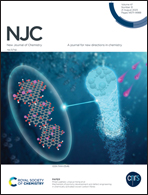Photoelectrochemical aptamer sensor based on AgInS2 and ZnS co-sensitized TiO2 for the detection of Hg2+†
Abstract
In this work, a photoelectrochemical (PEC) aptamer sensor using a TiO2/AgInS2/ZnS composite material as a photoelectric active anode substrate and NiCo-MOF@Au as a quenching element is constructed to detect Hg2+. Titanium dioxide (TiO2) was prepared by hydrothermal synthesis. The prepared TiO2 consists of rod-like aggregations with a unique structure and large specific surface area. TiO2/AgInS2/ZnS composites with higher photochemical activity were obtained by modifying AgInS2 quantum dots on the surface under electrostatic force and ZnS modification by the successive ionic layer adsorption and reaction (SILAR) method. The constructed PEC aptamer sensing platform has good sensing performance for Hg2+, and the detection limit is as low as 34 fM, showing high selectivity and reproducibility. At the same time, the application of this method in actual environmental samples is evaluated and satisfactory results are obtained. Therefore, the developed photoelectrochemical aptamer sensor provides a promising technique for the detection of Hg2+ in the environment.



 Please wait while we load your content...
Please wait while we load your content...